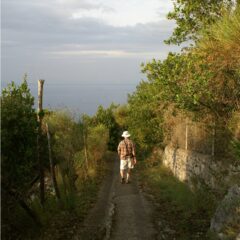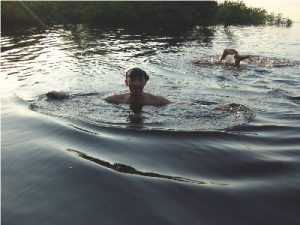Although Cumberland Island is a National Seashore, there is no bridge to get there, and we all like it that way. This treasure is the southernmost barrier island off the coast of Georgia (USA) at the mouth of the St. Mary’s River. Although inhabited for thousands of years, since the 1970’s most of the island has been under the control of the National Park Service which limits the number of visitors to the island to about 300 per day. The island is 17 miles long and 3 miles wide, so there is plenty of room to separate yourself from the crowd. Technically, there are some private landowners remaining on the island who are heir’s of the Carnegie’s and other long gone islanders, whose history is chronicled in the book Strong Women, Wild Horses, among others. I’ll only touch some of the island history to help you understand the place before you make your visit.
Other than the few private landowners and the Park Service employees, there are no vehicles allowed on the island, thus, for those of us who like hiking in serene silence away from the world, this is one of the places where most of the time you’ll be satisfied with what you hear. One shell packed road runs the length of the island and the eastern side of the island beaches on the Atlantic Ocean, so the beach is immense and virtually deserted.

The picture above is of the beach three miles from the ranger station. You can get there by walking or renting a bicycle and cycling along the road. Otherwise, you won’t see it. There are no developments on the beach and access across the dunes to the beach is restricted to a dozen or so well marked lanes. So, how do you really get to this reclaimed beauty? Read on.
If you have a private vessel capable of navigating the intercoastal waterway, you can get to Cumberland Island by yourself, but most of us rely on the ferry which is authorized by the NPS to carry visitors from the dock at St. Mary’s, Georgia to Seacamp dock on Cumberland Island. The ferry runs twice a day, once in the morning and once in the afternoon and takes about 45 minutes to get to make the trip. Pay attention to your return trip departure time because, although they count heads on the way to the island, they have no way of knowing how many are supposed to be on the boat on the way to the mainland, therefore, they don’t try to account for your return. There are also no provisions available on the island, so take your own water and food or buy some on the ferry. If you are making a day trip and want to rent a bicycle, you have to do it on the ferry. If you are staying overnight and want to buy firewood, the only place you can do that is on the ferry.
Once you are on the island, the choices and the distance between choices make the decisions for you. We wanted to backpack to Stafford Beach and camp at the campsites there. Another group that ferried over with us had young children and were headed to the campsites at Seacamp. A young couple on the ferry were backpacking a couple of miles beyond Stafford Beach and camping at an even more remote backcountry campsite. As you

guess, each option had its advantages and drawbacks. Seacamp is the closest to the dock and ranger station and about 1/2 mile along a sandy trail across the island. A number of campsites are arranged for substantial privacy and the campsite has running water, showers, toilet facilities and a group area. The boardwalk shown above leads from Seacamp over to the beach. You will have miles of beach in either direction, but you will be sharing it with the largest concentration of people on the island. Stafford beach is 3 and 1/2 miles from the dock along the parallel trail which is well-marked.

The trail more or less parallels the road, but is a far more enjoyable and easier hike. The trail cuts through the palmetto fronds beneath the live oaks and you soon lose sight of the road or where you came from. Watch your step because wild horses and wild hogs share the trails with you and leave their souvenirs along the way. As plentiful as the dung was, we never saw the hogs, although the population is such that the NPS has had to institute hunts to thin the herd. The twisted shapes of the live oak trees, the leaves filtering the sun and the limited distance visibility give the landscape along the trail a mystical and unreal quality. You would not be in the least surprised to see any creature from folklore stick his head around a tree and look at you . In all likelihood, you will see the wild horses on the island. They run free on the island at the command of Ms. Lucy Carnegie, grand dame and matriarch of the island’s Carnegie clan, as set forth in her will decades ago. At the time of the American Revolution, the live oaks were harvested for use in the sailing vessels of the day because of their great strength and resiliency. Barrier island oak was used in the USS Constitution and can be seen today if you visit the ship in Boston.
When you arrive at Stafford Beach camp, you can select from one of less than 20 campsites equipped with a fire ring. There is a common bathhouse with a cold water shower and toilets, however, any water from the area including the bath house has to be treated by boiling, filtering or chemicals before it can be consumed. Don’ t even brush your teeth with untreated water. Your campsite can range from extremely private to rather private depending on the proximity to the bathhouse. A trail runs across the dunes to the beach pictured at the top of the post. Although the rangers sometimes drive over to check on things, the only other people you will see on this beach are the ones who have hiked three plus miles to get there. They are there for the same reason you are: and that is nobody’s business.

We chose a campsite away from the bath house and away from the beach. As you can see it was great. We used the overhanging trees to suspend our supplies so the raccoons, squirrels and hogs couldn’t get into it. Note that firewood is scarce and you may want to bring a lightweight cutting implement to reduce what you may find to fit into the fire-ring. The campsites north of Stafford Beach are primitive. There are no bathouses and no potable water. These campsites are also not near the beach and at least one is on the intercoastal waterway side of the island. We haven’t made it to one of those yet, but the young couple we met came back smiling.
If you want to see the island and its history in a short amount of time, then you should take the tour. Fifteen passenger vans leave from the ranger station at the dock twice a day to take you on the tour. We walked the three and 1/2 miles back to the ranger station one morning to take the tour, only to learn that you have to by the tickets for the tour on the mainland before you get to the island. Be prepared. We walked the 7 & 1/2 half miles to Plum Orchard mansion, one of the many Carnegie mansions on the island and then the 4 miles back to Stafford Beach. It was worth the walk. A volunteer working in conjunction with the Park Service was at the mansion and gave us a great talk as he showed us around. A half mile or so south of the ranger station is the museum, housed in the Carnegie ice house and beyond that are the ruins of the main Carnegie complex, where Ms. Lucy held sway and before her the earlier claimants on this amazing island. Ms. Lucy’s Dungeness burned in the middle of the twentieth century but you can still sense its grandeur from the ruins.

At the north end of the island is the church where John F. Kennedy, Jr. got married, in between is the Greyfield Inn run by the Carnegie heirs, cemeteries, wild horses and maybe a few ghosts. Most of all it is a place to get away from it all. I’ll have more to say in a later post.














